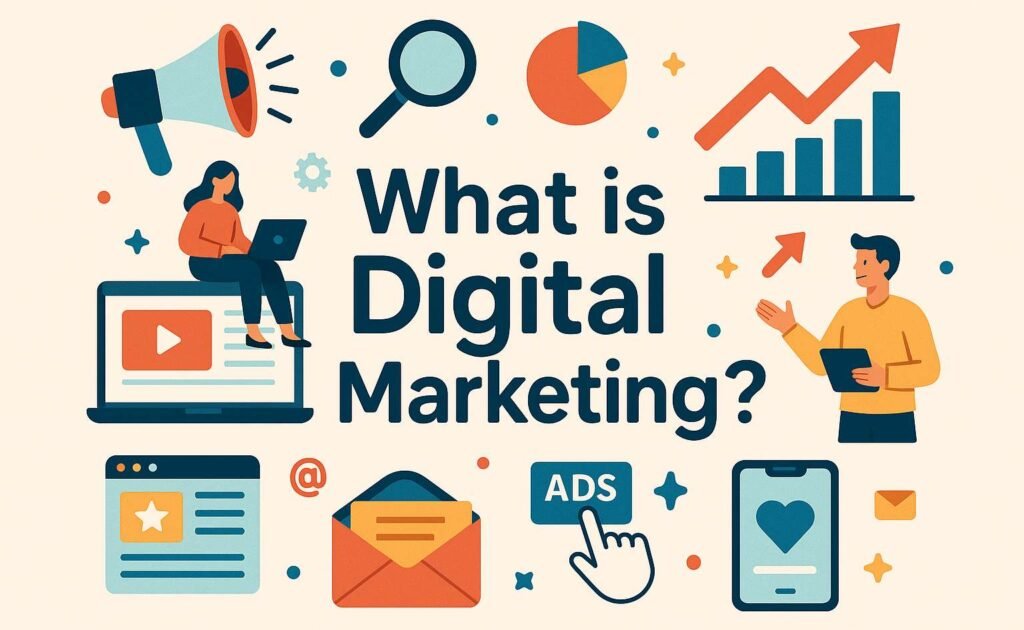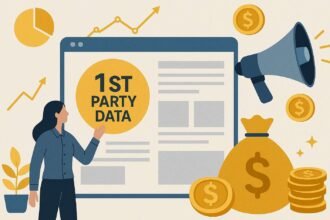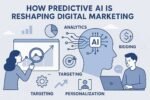Navigating the Digital Marketing Ecosystem
Digital marketing is an umbrella term for all online marketing efforts, covering paid channels such as PPC and display advertising alongside organic platforms like social media, SEO, and content marketing. The emergence of new formats such as in-app advertising, digital TV advertising, augmented and virtual reality has prompted marketers to develop an ever-expanding array of digital strategies.
A comprehensive digital strategy identifies the appropriate channels, platforms, and technologies to optimize user interaction and engagement. Digital marketing channels include search engine marketing (SEM), social media marketing, email marketing, content marketing, and affiliate marketing. Following business objectives, the strategy defines target audience personas, goals, metrics, business case, budget, and associated marketing mix elements. Search marketing activities are then planned across different digital channels accounting for the specific strengths of each platform.
Understanding Digital Marketing Channels
Navigating the Digital Marketing Ecosystem Digital marketing channel. In order to understand what “digital marketing” is, the strategy behind it and details of how it is executed, the main channels of marketing need to be defined. Digital marketing includes SEM (search engine marketing), social media marketing, email marketing, content marketing and affiliate marketing.
The first channel mentioned, SEM, is one of the most important strategies for marketing. Search engine marketing focuses on getting paid traffic from Google, Yahoo, Bing and many other Web search engines. The idea behind search engine marketing is to put yourself in front of potential customers exactly at the time they are searching for the product you advertise. Due to the instant demand generation at the perfect moment this is a very powerful form of marketing. Further, paid search engine marketing can co-exist with search engine optimisation (SEO) because of the different intent they serve for the same topic.
Social media has rapidly evolved from being just a way for people to connect and share their thoughts into a very powerful marketing tool. With the rise of Facebook, Instagram, LinkedIn and Twitter, an opportunity has opened up for marketers to engage with their customers and address their concerns on one-to-one basis. There are different nature of customers found on each social media site and marketing messages have to be tweaked to suit and make use of the individual features of each platform.
Search Engine Marketing (SEM)
Within the digital marketing ecosystem, search engine marketing (SEM) focuses on paid search advertising such as Google Ads. It encompasses paid strategies that complement the organic efforts of search engine optimization, which form the related functions of search engines. With SEM, advertisers bid on keywords that users of services such as Google and Bing might enter when looking for certain products or services, which gives the advertiser the opportunity for their ads to appear alongside results for those search queries.
Unlike search engine optimization, which accounts for organic search results, SEM deals with paid search placements. Its goal goes beyond just building awareness and is focused on acquiring the targeted website traffic that converts into sales. In addition to the tools provided by the platforms like Google Ads or Bing Ads, the use of analytics tools such as Google Analytics plays a role in SEM.
Social Media Marketing
Social media marketing employs various platforms to reach and engage with a brand’s target audience. The visual appeal of platforms such as Facebook and Instagram attracts substantial user attention, while Twitter’s rapid news cycle facilitates active debate and discussion. LinkedIn caters primarily to professionals, corporations, and business-to-business communications. Social media marketing encompasses a diverse range of resources and tools aimed at enabling brands to achieve their social media goals. Some of the critical steps involved include managing a business page that represents the brand and communicates with the audience, utilizing business tools provided by platforms to monitor growth and make informed decisions, running paid advertisements to reach a broader audience, employing scheduling software to plan and distribute content consistently, engaging with the audience through comments and direct messages, and sourcing user-generated content for credibility and reach.
Detailed explorations of marketing strategies tailored to specific platforms are available in the corresponding sections on Facebook Marketing, Instagram Marketing, LinkedIn Marketing, and Twitter Marketing.
Email Marketing
Email marketing is one of the oldest online marketing strategies, yet it remains the most effective way to reach customers directly through their accounts quickly. Although it is one of the first types of digital marketing, it is still very much alive and well today, with campaigns often still being quite successful in businesses of all sizes.
While social media platforms like Instagram, Facebook, Twitter, and even newer services like TikTok continue to grow and provide new opportunities for digital marketing, email still provides a more direct method of reaching consumers quickly than social media messaging platforms. The most significant negative association with email marketing is the effect of social media platforms on younger demographics, who tend not to use email as much as older demographics, as they utilize instant messaging platforms for their socialization. However, the most basic form of email marketing—sending out newsletters—remains one of the best ways to cap off a digital marketing campaign.
Content Marketing
Content marketing is a strategic marketing approach centred on the creation and distribution of valuable, relevant and consistent content in order to attract and retain a clearly-defined audience — and, ultimately, to drive profitable customer action.
The three main pillars of content marketing are: • Visual content: Visual content in the form of images and videos can deliver your marketing messages in a powerful way, resulting in high engagement and conversion rates. • User-generated content: Sharing reviews, testimonials and content created by your customers can build community and trust around your brand. • Blog content: Blogs provide a place to share news and information about your industry or niche. Including keywords within your blog articles can go a long way towards ranking on search engines.
Content creation best practices are covered in a separate section. Content marketing is an important strategy in its own right and should not be confused with copywriting. While copywriting involves persuading a customer to purchase, content marketing attempts to create a long-term relationship with your customer’s audience.
Affiliate Marketing
Affiliate marketing is another type of performance-based marketing. In affiliate marketing, a business rewards one or more affiliates for each visitor or customer brought by the affiliate’s own marketing efforts.
Affiliate marketing differs from search engine marketing, in that advertisers pay for affiliates to send visitors to their websites rather than paying for visits generated through paid search engine results.
Key Components of Digital Marketing Strategy
Digital marketing encompasses all marketing activities conducted through online media to promote products and services. The main goal is to reach customers by taking advantage of the digital environment. A digital marketing strategy is a plan designed to facilitate this objective. It is essential to determine the appropriate audience, set reasonable goals and objectives, and establish a marketing budget. Different digital marketing channels are available, including search engine marketing, social media marketing, email marketing, content marketing, and affiliate marketing.
Any digital marketing strategy begins with a budget and the identification of the intended audience. These initial steps shape the selection of the most effective channels. Search engine marketing uses paid advertising campaigns. Social media marketing leverages platforms such as Facebook, Twitter, LinkedIn, and Instagram. Email marketing employs personalized e-mail blasts—in different formats—to engage potential and current customers. Content marketing involves creating, publishing, and distributing valuable, relevant, and consistent content to attract and retain a target audience and drive profitable customer action. Affiliate marketing engages publishers who create content and drive traffic back to the company’s website.
Target Audience Identification
The initial step in a digital marketing campaign is audience identification. Instead of targeting everyone, which can be a costly mistake, it is essential to define precisely whom you want to reach. Each advertising campaign should have a specific audience in mind to ensure budget optimization and effective engagement.
For example, a product like Nike running shoes may not appeal to women but is popular among runners; therefore, a campaign targeting fashion-interested women would likely fail. Google Ads offers a range of targeting methods—including keywords, locations, demographics, times, and budgeting—that help deliver the right message at the right place and time. In summary, audience identification focuses on targeting the buyer persona, step one of any well-planned digital marketing campaign.
Setting Marketing Goals
Setting marketing goals is a crucial step in every digital marketing strategy. Without a goal or set of goals, it’s like trying to navigate a road trip without a destination or map. Setting marketing goals helps your team figure out the direction to take in your digital marketing efforts.
Without goals and a plan, your digital marketing efforts will meander in many directions without ever producing measurable results. Only when you have clear goals can you set a budget that aligns with the priority of the business or organization. What gets measured, gets managed.
Budgeting for Digital Marketing
Budgeting for digital marketing is a critical phase in the strategic planning process. It requires estimating the necessary budget to reach a defined target audience and support chosen strategies. Digital marketing strategies often incorporate various channels, each governed by separate budgets. Ad budgets and digital marketing budgets, for example, are allocated to paid efforts designed to attract customers. These budgets are based on audience customer journey analysis, which maps potential customers’ transitions from strangers to promoters of the brand. A well-allocated budget ensures non-paid parts of the strategy receive appropriate attention and resource allocation.
An overarching set of customer journey phases is employed to guide budgeting decisions. This model aids in estimating an overall budget for each marketing tactic, ensuring that allocated funds address the correct audience for each initiative. Unlike traditional marketing, digital marketing encompasses several ways to allocate online marketing budgets: upon the number of unique visitors drawn, the number of clicks generated, the number of conversions, or the number of impressions. These approaches provide the flexibility to support various strategic objectives.
Search Engine Optimization (SEO)
Search engine optimization (SEO) is a discipline within paid search marketing that focuses on increasing the visibility of websites and pages in organic (non-paid) search rankings. Various search engines use algorithms based on numerous ranking factors to determine the position and ranking value of sites in their results pages. Because the majority of clicks on any search engine results page (SERP) are on natural, organic results, an effective SEO strategy can result in large volumes of website traffic.
Three primary areas of SEO are recognized: on-page SEO, off-page SEO, and technical SEO. On-page SEO focuses on improving features within individual pages, such as heading tags and content creation. Off-page SEO concentrates on earning backlinks from external websites and social media. Technical SEO seeks to enhance the overall infrastructure of a website to ensure fast loading and mobile optimization, thereby supporting broader on-page and off-page endeavors.
On-Page SEO Techniques
Digital marketing uses digital channels such as search engines, social media, email, websites, and blogs to promote and market products or services. A digital marketing plan defines clear objectives and KPIs, chooses appropriate digital marketing channels, and controls investments and risks. Search engine marketing (SEM) promotes products or services through paid ads on search engines. Social media marketing involves activities on platforms like Facebook, Instagram, LinkedIn, and Twitter that enable individuals and communities to share, co-create, discuss, and modify user-generated content. Email marketing targets existing and potential customers through email communications. Content marketing aims to obtain and engage customers through various types of content. Affiliate marketing involves the promotion of products or services of third parties in exchange for a share of commissions.
Three main factors are considered when formulating a digital marketing strategy: defining the target audience (demography, income, age, gender, area, and culture), outlining marketing goals, and allocating the marketing budget. Search engine optimization (SEO) refers to steps taken to improve a website’s ranking in search engine results. On-page SEO optimizes visible page elements such as the content itself, page titles, heading tags, URLs, internal link structures, and schema markup. Off-page SEO involves advertising and backlinking, while technical SEO focuses on content delivery factors like server response time, indexing, rendering, and website security. Additionally, a variety of social media marketing strategies are used on different platforms. Creating compelling content is essential for decision-making across all digital marketing activities. Analyzing current performance through key performance indicators enables digital marketers to adjust their strategies accordingly.
Off-Page SEO Strategies
Digital marketing utilizes digital channels to achieve marketing goals. The term emerged with the growth of digital media and technology during the 1990s and 2000s. Today, digital marketing can be pursued through email, social media platforms, search engines, and websites.
Search engines are essential to digital marketing. They act as a connection between brands and customers when a customer searches online. Paid ads on search engines link customers with product or service providers. Pay per click ads (PPC ads) appear on top of the major search engines’ result pages. An effective digital marketing strategy employs both paid and organic methods. Paid ads generate quick responses and lead in conversion, but they lack long-term value. Organic ads generate leads without directly driving sales.
Popular social media platforms enable companies to connect directly with current and potential customers. YouTube is the fastest developing social platform, followed by Facebook, Instagram, Twitter, Pinterest, LinkedIn, and Snapchat. E-mail marketing played a crucial role in early digital marketing history. Paid ads can also be posted on email platforms, featuring brief content and a call to action. Content marketing bank on offering meaningful information and engaging customers rather than directly trying to sell a product.
Affiliate marketing is another popular avenue, where the brand integrates marketing activities with affiliates who promote the brand. Several factors contribute to the success of any digital marketing campaign. Understanding the audience is crucial. The target audience can be identified through demographic and psychographic profiles. Typical marketing goals include increasing brand awareness, building customer engagement, and directing traffic to websites. Identifying financial resources helps determine the scope of the campaign.
Search engine optimization (SEO) increases the ranking of a website on search engines. It is a complex bundle of on-page SEO, off-page SEO, and technical SEO. Off-page SEO refers to external factors impacting a website’s ranking. Off-page SEO signals show how the world outside a website ranks it, emphasizing the importance of creating a reputation for both users and Google. These signals significantly influence rankings.
Technical SEO Fundamentals
The mechanics of site and server optimizations that enable search engine spiders to crawl and index a website more effectively are known as technical SEO. The curation of website and server attributes can influence the ratings that search engines assign to websites, which in turn affects where they land in search engine results pages (SERPs). In addition, it can help make it easier for search engines to locate and index websites. Technical SEO includes modifications to a website’s structure, such as an upgrade to HTTPS, a reworking of a URL tackle, and the implementation of schema markup. These adjustments can help improve rankings. In addition, there are changes that can be made to a website in order to make it more searchable through search engines. Search engines utilize website sitemaps and robots.txt files in order to locate and index the pages of a website in an effective and efficient way.
Additionally, it is essential for a website to have only one version of its pages in order to avoid duplicate content. Duplicate content has the potential to jeopardize the site’s rating performance. Ensuring that there is only one version of a page, with a clear preference, can be a beneficial practice.
Social Media Platforms and Their Uses
Social Media Marketing is an important part of every digital marketing strategy. Brands use social media channels to improve awareness, foster community among their audience, support SEO, drive traffic to their websites, educate customers, generate leads and engage with current customers.
Social media platforms enable direct interaction with brands across the customer journey and provide authentic content that influences purchasing decisions. Popular platforms include Facebook Marketing, Twitter Marketing, Instagram Marketing and LinkedIn Marketing.
Facebook Marketing
Facebook advertising is a form of digital advertising that has rapidly gained importance alongside Google Ads and Google Grants advertising. Facebook has a broad range of targeting options and detailed analytical tracking, making it valuable for organisations in all sectors. Facebook advertising enables organisations to reach potential customers in specific geographic locations and with specific interests or demographics.
Facebook advertising still provides some of the highest performing global digital marketing campaigns; therefore, utilizing its advantages is generally a beneficial strategy for organisations seeking to enhance their customer base. Facebook advertising is linked with Instagram marketing since Facebook owns Instagram and uses the same social media manager platform for campaign creation and management.
Instagram Strategy
explores the world of the photo-sharing social media platform, showing how Instagram can benefit a business and providing advice on building an effective strategy. Instagram offers a powerful visual storytelling platform with a user base of 2 billion people, making it a fertile ground for creating brand awareness. Moreover, Instagram boasts the second-highest organic engagement rate among all social media platforms, with an impressive 1.22%. For businesses aiming to leverage visual content to captivate, inspire, and influence their target audience, Instagram serves as an excellent option.
To succeed on Instagram, it is essential to follow best practices and implement strategic steps. This guide outlines the optimal times to post, recommends effective marketing techniques, and offers tips for gaining followers, thereby maximizing the platform’s benefits and enhancing business appeal.
LinkedIn for Professionals
LinkedIn is a marketing tool that everybody should know about. It is very useful for professionals and executives in organizations offering B2B services. Established in 2003, it has grown to be the world’s largest professional networking site with over 600 million users in more than 200 countries and territories. Predictably, marketing on LinkedIn is quite different from other social media platforms. The LinkedIn Ads platform allows marketers to target their audiences based on various demographic features. The other type of sponsored content is the manually published posts directly on the business account.
Unlike Facebook, the Facebook audience network is not supported for LinkedIn Ads, but YouTube does run on the Bing engine, so ads on YouTube are supposed to be covered by Bing ads. Generally, CPC rates are better for Bing compared to Facebook, leading to lower overall CPC when using both Bing and Facebook. Hashtag research is also important for starting up on LinkedIn. Hashtags allow the user to identify what is trending and join conversational topics.
Twitter Engagement Techniques
Connecting with your audience on Twitter and encouraging them to engage with your content not only increases site traffic but also boosts brand awareness and fosters trust among users. A higher volume of followers can increase your credibility, encouraging more users to follow you and share your content.
Use these methods to encourage engagement: – Ask questions. One of the easiest ways to encourage users to engage with your content is simply to ask questions. Make them interesting and relevant to your brand and customers. – Answer questions. Help build your brand and maintain customer trust by answering questions they may have about your brand or your products. – Share user-generated content. Reposting an image of a customer using your product not only adds a personal touch to your feed but also establishes trust among new customers.
Creating Effective Content
Creating high-quality, engaging, and shareable content is essential for any involved digital marketing campaign. It should provide value to all stakeholder groups, including the business or organization, customers and potential customers, affiliates, and business partners. The content must be designed to move potential customers through the different stages of the marketing funnel, from awareness to consideration to decision, purchase, and advocacy. The content of the message should correspond with the platforms and formats used to transmit it, so linked, user-generated, visual, and video content represent opportunities to reach these diverse stakeholder groups, as well as to reach smaller or more niche groups of individuals who otherwise would not be served.
The ability to provide relevant, helpful, and in some instances entertaining content at almost any moment of interest has widespread advantages, ranging from the ability to more easily build brand awareness and reputation to the ability to more effectively attract customers and increase sales. Content creation represents the act of crafting content and messaging for these purposes.
Content Creation Best Practices
Content lies at the heart of most digital marketing channels, whether engaging customers via social media, email, or a search engine marketing campaign. High-quality content engages visitors and makes them want to stay longer. Visitors stay longest when content answers their questions, solves their problems, or fulfills their needs. Content can take nearly any form—from text, images, and videos on web pages to photos on Instagram, tweets on Twitter, videos on TikTok, podcast episodes, brochures on Pinterest, or email newsletters. Creating engaging content relevant to the target audience is crucial, and businesses should consider including non-promotional user-generated content that customers also find interesting.
Creating a diverse content mix is vital for engaging different audience segments at various stages of the buyer journey. Ideally, content should be created as part of an overarching content marketing strategy that draws on keyword research and detailed audience personas. Ensuring that content creation enables digital marketing measurement also contributes to a more successful content marketing strategy.
Visual Content Strategies
Digital marketing is the application of digital tools and technologies in order to achieve marketing communication objectives. It is similar to traditional marketing methods but incorporates digital channels such as search engines, social media platforms, and websites. The growing number of digital users demands a new digital approach in marketing for brands to communicate well with their target audience and achieve their campaign objectives.
Visual content is a powerful tool for attracting customers to products and services. However, creating engaging visual content requires strategic thought. Businesses of all sizes can harness the marketing lessons of visual content to enhance customer engagement. Designing separate visuals for each post can be both time-consuming and expensive. Visual marketing is on the rise across all social media platforms. Beyond graphics and photos, it also includes videos, slideshows, GIFs, memes, and other visually stimulating formats. Questions concerning the use of original images, branded stock photos, user-generated content, or other types of visual content are quite common.
User-Generated Content
User-generated content (UGC) comprises media that originates directly from unpaid consumers or end users in the form of videos, blogs, discussion form posts, digital images, testimonials, audio files, product or service reviews, recipes, tweets, and more. It frequently promotes engagement with a brand’s content, enhances public relations, and can make a brand seem less “corporate” and thereby more “credible” to the consumer. UGC is closely linked to the marketing concept of creating content that goes viral and frequently employs the use of “memes” for humorous effect.
User-generated content in terms of digital marketing and brand building can be extremely powerful. It is a way the company supporting the brand can actively: engage with and build a community, gain exposure on social media platforms such as Facebook, Instagram, and Twitter, improve SEO through regular posting of high-volume keywords, and collect and showcase honest customer feedback both written and visual. Moreover, user-generated content, particularly when it is visual in nature, influences purchase decisions.
It is important to understand that consumer-generated opinions are more easily accepted by other consumers in comparison to advertising. Over 70% of consumers on social media trust recommendations from real people, as opposed to just 10% that trust brand messages. Consumers believe this type of content is authentic to a brand; it is relatable and has a personal heart and emotion. These reviews and engagement not only affect a brand’s reputation but also contribute to its bottom line. UGC acts as a powerful tool to spread brand awareness and creates an ongoing relationship with the brand around the world. Consumer images, videos, and reviews shoppable by brands allow consumers to feel more connected with the products and associate them with a particular brand through sharing, commenting, and liking on social media platforms.
Brands have increasingly utilized UGC content in advertising campaigns, not only for the benefit of perceived authenticity but also due to its low cost and the high level of engagement it brings.”
Analyzing Digital Marketing Performance
Analyzing digital marketing performance requires the use of specific Key Performance Indicators, or KPIs. A KPI is a metric that tracks and measures the performance of digital marketing activities; the more aligned a KPI is with a specific marketing goal, the better it can measure whether or not the strategy is working. Numerous KPIs exist, and while some are universal and will work for almost any marketing strategy, others are unique to a specific strategy or channel. More information on KPIs and how they align with marketing goals is available in Setting Marketing Goals.
Google Analytics is a powerful tool for tracking and analyzing the effectiveness of digital marketing programs, especially when the goal is to drive traffic to a website. Google Analytics provides information on who is visiting a website, how visitors found the website, what they are doing on the website, and how they interact with an email marketing campaign. Additional tools and concepts to measure and optimize digital marketing campaigns include A/B testing.
Key Performance Indicators (KPIs)
In digital marketing, key performance indicators (KPIs) are quantifiable measures that indicate the success of an organization in meeting its specific marketing objectives. By benchmarking and evaluating business initiatives, KPIs enable organizations to gauge marketing performance from all perspectives, including return on investment, search engine rankings, operational efficiency, and social media engagement.
Common KPIs measured over a predefined period include search engine rankings, traffic, lead conversion, sales, and others. Digital marketing directors analyze KPIs to determine whether their marketing activities are achieving their stated objectives. If performance falls below set standards, adjustments to the marketing investment mix may be necessary. Defined on a case-by-case basis, KPIs are distinct from business metrics, which encompass company-wide performance indicators. Measuring and analyzing KPIs lies at the heart of web analytics.
Using Google Analytics
Google Analytics is an essential tool for examining digital marketing data and performance. Widespread adoption means that many companies using Google Analytics also employ Google advertising services such as Google Ads, Google AdSense, the Google Display Network, or YouTube advertising. Google Analytics helps users define key performance indicators (KPIs) and set up goals to assess the effectiveness of advertising campaigns and visitors’ interactions with a website. Through appropriate tagging of URLs, users can also evaluate Google Ads campaigns.
Google Analytics allows marketers to create customized dashboards displaying data in a comprehensive and organized manner. Visitors can be segmented into different categories, such as purchased/not purchased, visited specific areas of the website, used desktop/mobile/tablet, etc., enabling deeper analysis of marketing efforts. The inclusion of convertable goals permits evaluation of shopping cart utilization and checkout processes. The platform also supports A/B testing and third-party integrations, making it possible to conduct real-time analysis, tests, and statistics.
A/B Testing and Optimization
Digital marketing is the umbrella term for all online marketing activities. It plays a vital role in modern business, especially for small and medium-sized companies, leveling the competitive field with bigger enterprises and opening new market opportunities worldwide. Any brand wishing to connect with current customers or attract new ones must invest in digital marketing. Business owners may be overwhelmed by the numerous choices available: Social Media Marketing, Search Engine Marketing, Email Marketing, Affiliate Marketing—or various combinations thereof. An effective strategy begins by determining your target audience, defining clear objectives, and setting a realistic budget.
A/B Testing, also known as Split Testing or Bucket Testing, is an experimental phase.Generally, Google Analytics and Google Ads, among other tools, are employed to perform the A/B test and monitor the achieved results. It involves comparing two versions of a digital marketing element to identify which one performs better with the audience. In a typical A/B test, only one element differs between versions. A common example is modifying the call to action on a landing page to gauge its impact on conversions.
Emerging Trends in Digital Marketing
Artificial intelligence (AI) is playing a critical role in shaping the future of digital marketing, enabling data-driven decisions and supporting marketing efforts such as content creation, content marketing, and social media management. About 80% of content marketers already use AI to enhance their content strategies through data analysis, plagiarism checks, deciding what content to publish and promote, and scheduling content. Moving forward, advanced AI tools capable of directly creating content are expected to further transform how marketing content is developed in general.
Voice search, enabled by gadgets such as Google Home, Apple Homepod, and Amazon Echo, is rapidly gaining popularity among consumers for queries. To prepare for the increasing use of voice search, companies should prioritize incorporating keywords and sentences that reflect natural speech patterns in their search engine optimization (SEO) strategies. Video content around products is another trend gaining traction in digital marketing. These trends underscore the importance of evolving digital marketing strategies to meet changing consumer behaviors and preferences.
Artificial Intelligence in Marketing
Artificial intelligence (AI) can be regarded as the ability of machines and software to perform cognitive tasks for which one normally would seek human expertise. Examples of such tasks include deduction and reasoning, perception, social intelligence, creativity, and the initiation and transfer of knowledge. AI in marketing can be implemented through deep learning, machine learning, and natural language processing.
Deep learning uses multiple layers of neural networks to apply full supervision and fully utilize structured big data, enabling systems designed with minimal human intervention to learn with accuracies beyond the reach of humans by finding patterns hidden in big data. Machine learning uses a mathematical model to help a system accomplish a specific task without being explicitly programmed for this task and learns from sophisticated algorithms and data relationships. Natural language processing analyzes human-created content such as text, speech, images and video to understand human emotions, thoughts, and topics. With this technology, a simple chatbot can understand the intent of a question, speech, or simple video on social media; extract the emotional label; and be trained to draft an appropriate response to the consumer.
Voice Search Optimization
Search engine marketing (SEM) is a form of Internet marketing that involves the promotion of websites by increasing their visibility in search engine results pages (SERPs) primarily through paid advertising. Search engines reward paid ads by displaying them in prominent positions on the SERP. This promotion strategy seeks to place ads in visible spots on the page, within Google search results, and within shopping services (Google Shopping ads). Social media marketing promotes products and brands through social media platforms. Instagram marketing in particular serves as an important platform for pharmaceutical and scientific companies. Official Facebook pages are very important for customer engagement. LinkedIn helps companies reach a professional, business-oriented audience. Twitter is a platform designed for broadcasting short messages. Email marketing remains a highly popular and effective form of direct communication with customers. Content marketing focuses on creating and distributing educational, useful content for end users.
These elements of marketing can be considered part of a modern marketing strategy or business model. The essential components of any marketing strategy include identifying the target audience, setting SMART (Specific, Measurable, Achievable, Realistic, and Timely) goals, and determining the marketing budget. Search engine optimization (SEO) is a fundamental element of successful digital marketing in regard to organic traffic sources. It involves growing organic traffic through high ranks on search engines. The subcomponents of SEO include On-Page SEO, Off-Page SEO, and Technical SEO. On-Page SEO involves the optimization of content on the website itself. Off-Page SEO is dedicated to external signals such as backlinks that help build the website’s reputation and authority. Technical SEO covers website and server optimizations that help search engine robots crawl and index the site more effectively. Several marketing methods are incorporated under this topic. The on-page methodology aims to make the website light and well-optimized in order to provide a good user experience to visitors. Highly ranking websites in Google are the most trustworthy.
Voice search is a trending technology that has gained popularity since the rise of Google Assistant, Amazon Alexa, Apple Siri, and Microsoft Cortana. It provides users with a convenient and efficient way to get answers to their queries and search for products and services on mobile. The number of voice searches is predicted to grow rapidly in the coming years. The reason for voice search’s popularity is that it allows users to perform searches on the go, unlike today’s screen-based technology. In particular, Google has changed the meaning of keyphrases from the perspective of voice search, and these changes align with the increasing market share of voice search. Voice search has also contributed to the changing nature of featured snippets. More recently, Google has started showing featured snippets for searches performed via voice search on the mobile phone.
The Rise of Video Marketing
Historically, video production placed the medium beyond the reach of many organizations, but the current ease, speed, and cost-effectiveness of online video content shift the balance. The rapid growth of video, especially on social media, makes the possibilities particularly visible. Many organizations use video to promote their corporate brand, but a growing number include videos within marketing campaigns to offer additional product information or to engage customers in interactive co-creation processes. Videos can be updated relatively frequently, enabling marketers to maintain marketer–customer dialogues. A special characteristic of interactive co-creation is that reactions and users’ additions are highly visual. Older populations and emerging markets also find video useful, as they enable low-literacy or low-linguistic-proficiency users to understand marketing information.
Ethics and Best Practices in Digital Marketing
The growing dependence on the internet and digital channels raises serious issues related to customer privacy and transparency. Privacy concerns are common for both users and organizations; on one side, consumers lack control over the disclosure and use of their data, typically required to engage with organizations. On the other side, organizations strive to provide transparency in their operations while protecting themselves and their customers’ privacy. Transparency issues involve a lack of accurate, accessible, and timely product and service information, inefficient reporting systems, low responsiveness to customer complaints, and unfair terms and conditions.
The exponential growth of digital marketing poses many challenges, including privacy, intrusion, fraud, ethics, and security. Digital marketing principles guide organizations in effectively engaging audiences within this emerging environment. Despite enablers such as global reach, improved relationships, greater return on investment, and the ability to compete on many levels, perceived barriers can make digital marketing seem riskier and less controllable than traditional marketing. Engaging effectively in digital marketing requires concerted efforts to respect privacy, build transparency, and adhere to ethical guidelines.
Privacy Concerns
Public awareness of data privacy risks is growing rapidly. Worldwide, privacy and data regulations are becoming increasingly stringent—especially in the E.U., where the GDPR was the first comprehensive internet privacy regulation. Advertisers who focus on digital marketing must be especially meticulous about respecting users’ privacy and avoiding any actions deemed invasive. Such practices not only build trust with your customers but also keep your business legally compliant and shielded from costly penalties.
Indeed, when it comes to online advertising, the protection of personal data ranks amongst the top global priorities. With privacy mechanisms undergoing continuous adjustments, online marketers face major challenges in balancing personalized consumer experiences with data security. Several industry-wide initiatives have emerged to address these concerns—for example, Google’s introduction of the Privacy Sandbox and Apple’s App Tracking Transparency (ATT) framework are paving the way toward a more privacy-respecting internet.
Transparency in Advertising
Transparency in advertising is an important ethical consideration for digital advertising. With the growth of sponsored and controlled content, whether it is a blog post, news feed item, video, or some other form of business or artistic creation, it is important to let consumers know which items actually have a commercial purpose. Social media sites have new features that require disclaimer tags when showing sponsored or promotional posts. Disclosure of a paid partnership or sponsorship allows social media followers to know when their favorite artists or creators are participating in paid activities or promotions. The platform’s business product manager explains that the disclaimers have been implemented “to help increase transparency and maintain authenticity.”
The Federal Trade Commission has posted digital advertising guidelines dedicated to such disclosures. The FTC guidelines state that blogs and video tutorials must disclose any paid sponsorships or brand ambassadorships. Even product packaging, product reviews, unboxing videos, or displaying a brand’s logo require clear disclaimers. Other best practices include keeping disclosure simple and clear. Brand and agency representatives are encouraged to establish legal contracts to ensure that content creators disclose sponsorships.
Conclusion

Digital marketing includes all marketing efforts that use an electronic device as well as the internet. Businesses leverage digital channels such as search engines, social media, email, and other websites to connect with current and prospective customers. The community of people that use a specific device/platform and who interact with other people using the same device/service are considered the “target audience”. In general, the target audience is differentiated by parameters such as age, gender, culture, human behavior, social profiles, economics, hobbies, etc. Targeting these specific groups helps companies achieve their objectives and capture more foregrounds.
The digital marketing strategy consists of web presence, goals, budget, and content. Web presence means deciding the platform for business operation, e.g., website, social media pages, and image search engines like Google. Setting goals for the company includes customer acquisition, follow-up, cross-sell, or customer service. Then, based on the goals, an allocated budget helps in choosing paid, unpaid, or hybrid promotions. Content is the key to digital marketing; no matter which platform is chosen, content plays an essential role in attracting more traffic. Performing some additional tasks like adding Google Ads to a website can further increase web traffic.












